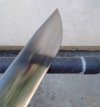- Joined
- Oct 25, 2003
- Messages
- 703
Blade profile is everything. It's the art of the design and the eternal goal.
All knives can stab, if that is the sole purpose, get an ice-pick. It's better.
Knives were meant to cut. A thick, reinforced edge will hold up, but it's not a slicer. A thin razor edge is a slicer, but it might not hold up. The Holy Grail of knife design is an edge that will slice like a razor, but be tough enough to chop. A thin, flexible blade that is just as tough as a thick, inflexible blade.
To test the edge for toughness, chop into a copper pipe. If it passes that test, move on to the clothesline.
1) Get a length of polyester rope, the thin softer kind.
2) Make a loop in it with your weak hand.
3) Insert the knife. Pull it taught, don't try to cut, just pull it tight.
4) Now cut, see if it will with one pass. You might be surprised.

All knives can stab, if that is the sole purpose, get an ice-pick. It's better.
Knives were meant to cut. A thick, reinforced edge will hold up, but it's not a slicer. A thin razor edge is a slicer, but it might not hold up. The Holy Grail of knife design is an edge that will slice like a razor, but be tough enough to chop. A thin, flexible blade that is just as tough as a thick, inflexible blade.
To test the edge for toughness, chop into a copper pipe. If it passes that test, move on to the clothesline.
1) Get a length of polyester rope, the thin softer kind.
2) Make a loop in it with your weak hand.
3) Insert the knife. Pull it taught, don't try to cut, just pull it tight.
4) Now cut, see if it will with one pass. You might be surprised.



